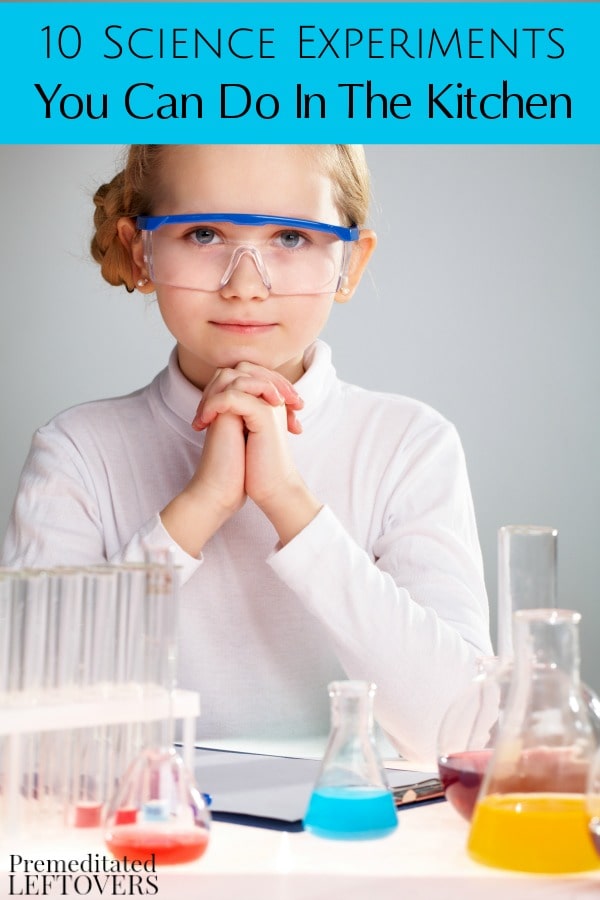Science Experiments for kids are so much fun and easy to do at home without any fancy tools. Here are 10 Science Experiments You Can Do in the Kitchen!
One of the best things about homeschooling is that you can do more with your kids than most school systems can do. Not only are science experiments like this fun, but they are educational in more ways than one. Check out some of our favorite experiments you can do with kitchen supplies. Here are 10 Science Experiments You Can Do in the Kitchen.
10 Sciences Experiments You Can Do in the Kitchen
1. Make Crystal Candy- Who knew that making candy could be so educational? Anything you can make in the kitchen is educational because cooking uses chemistry (mixing ingredients together for a result). Here’s how to make your crystal candy:
- Bring 1 cup of water to a boil.
- Stir in about ¼ cup of sugar at a time into the boiling water until the sugar dissolves. Keep adding sugar up to about 3 cups.
- When no more sugar will dissolve, remove it from the heat and let it cool for 20 minutes.
- Pour the solution in a jar. Hang a wooden skewer in the middle of the jar without touching the sides for 3-7 days.
What happens to your sugar solution?
2. Soda Bottle Explosion- Have you heard the theory that placing Mentos in a soda bottle will cause it to explode? Is it true? Let kids make a hypothesis, test their experiment, and write down their results with this super fun and exciting science experiment. What happens when you put 1, 2, 3 or even 4 Mentos in the bottle?
3. Make Oobleck- It’s a liquid, it’s solid, it’s Oobleck! Oobleck takes science to a whole different level as your kids try to figure out whether it’s a solid or a liquid. All you need for this fun experiment is water and corn starch. Add corn starch to a container of water a little at a time until it has a gooey consistency.
4. Edible Playdough- Making edible play dough is a big hit with kids. Not only is it a great way to teach the concept of chemistry, but it helps them build other skills such as creating letters, numbers, or words with the play dough. There are tons of edible play dough recipes. Choose one that your kids will want to eat when they are done.
5. Homemade Ice Cream- The key to this experiment is in the science! Lesson to the wise: if you don’t use rock salt, your mixture never turns into ice cream. Here’s what you need:
- 1 tablespoon sugar
- ½ cup milk, cream, or half and half
- ¼ teaspoon vanilla extract (or another flavoring)
- 6 tablespoons salt
- Enough ice to fill the gallon-sized bag halfway
- 1 gallon-sized plastic zip bag
- 1 pint-sized plastic zip bag
Put your ice and rock salt in one plastic zip bag. Put all other ingredients in another bag. Place the mixture in the bag with ice and salt (make sure it is zipped tightly), and shake up your ice cream until it thickens.
6. Egg Float- Learn about density by trying to make an egg float. Fill 3 cups full of water. Drop a few different colored drops of food coloring into each glass to keep the glasses separate. Plop your eggs in the cups and watch them sink to the bottom. Leave the first glass as it is, add 2 tablespoons of salt to the second glass, and 4 tablespoons to the third glass. What happens to the eggs? Which one floats? Salt makes water more dense or heavier than the egg when enough of it is put in.
7. Magic Milk- Colors are fun! When you use milk, food coloring, and a drop of dishwashing soap, you can create a magical canvas filled with color. This chemical reaction allows kids to learn colors, understand chemical reactions, and get creative. Pour ½ a cup of milk on a plate, put different colored food coloring drops all around it, and add a drop of dishwashing liquid to the center to turn your milk into magic.
8. Whipped Butter- Did you know you could make butter like the Pilgrims used to do? Not only is this a great science experiment, but it can add culture and history into your child’s education. Get a glass baby food jar. Fill it ¼ of the way full with heavy whipping cream. Let your kids shake the baby food jar vigorously until butter forms.
9. Make Explosions- Aren’t chemical reactions fun? When mixed together, vinegar and baking soda have an explosive personality. Here’s how you do it:
- Place 2-3 Tablespoons baking soda in the bottom of a jar or cup.
- Add 6-7 drops of food coloring
- Quickly pour in about 1/2 cup vinegar. Watch for an explosion!
10. Homemade Soil- It is tough for kids to understand that the food we eat can be turned back into the soil which is then used to make more food to eat. Here is a fun way to make compost and explain the natural process:
- Place chopped up fruits and veggies into a plastic zip bag.
- Add a few spoons of water.
- Zip the bag up with a straw in the corner for air.
- Mush the bag up for a couple weeks, and wait for it to turn into soil.
- Keep a journal each day like a real scientist.
What other kitchen science experiment ideas have you done with your kids? Share some fun experiments in the comments below!
More Science Experiment Ideas:
Magnet Science Activity For Kids
Easy Water Science Experiments For Kids
7 Ways To Use Apples To Teach About Science
How To Teach Kids Science Skills In The Garden


Leave a Reply